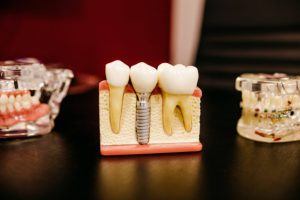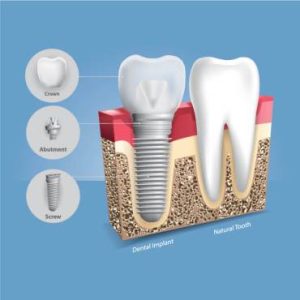 Dental implants are a safe, simple and effective long-term solution for missing or damaged teeth. They are often used as an alternative to dentures or bridgework because of their natural appearance and strength when used to chew food. They also have the added benefit of maintaining bone which helps prevent you from developing a defect in the dental arch where a tooth has been lost. People have been placing dental implants for a long time, in fact, ancient dental implants have been traced back to around 600 AD, when tooth-like pieces of shell were hammered into the jaw of a Mayan woman.
Dental implants are a safe, simple and effective long-term solution for missing or damaged teeth. They are often used as an alternative to dentures or bridgework because of their natural appearance and strength when used to chew food. They also have the added benefit of maintaining bone which helps prevent you from developing a defect in the dental arch where a tooth has been lost. People have been placing dental implants for a long time, in fact, ancient dental implants have been traced back to around 600 AD, when tooth-like pieces of shell were hammered into the jaw of a Mayan woman.
Fortunately, dental implants and the procedures used to place them have advanced drastically in the last two and a half millennia. Read more below to educate yourself on the procedures and materials used to perform modern dental implant surgery.
What is a dental implant?
A dental implant (also known as an endosseous implant), is a surgical component that interfaces with the bone of the jaw or skull to support a dental prosthesis such as a crown, bridge or denture. It may be easier to visualize if you think of a dental implant as an “artificial tooth root”.
A dental implant has three components:
- Screw
- Abutment
- Crown (or other dental prosthesis)
The first step in placing an implant is “implant surgery”. In this step, the “screw” component is placed into the jawbone. Over time, the implant screw will fuse to the jawbone through a biological process called “osseointegration,” where bone fuses tightly to the surface of specific materials, such as titanium or ceramic. This integration of the implant screw and bone is what enables modern dental implants to support physical loads for decades without fail.
The second step in the dental implant process is the placement of the “abutment.” One can think of an “abutment” as a sort of connector. It goes in between the “screw” and “prosthesis” components of the dental implant. The purpose of an abutment is to help one’s gums heal properly following dental implant surgery, as well as provide greater compatibility than an implant screw when placing different kinds of dental prostheses.
The final step in the dental implant process is the installation of the “dental prosthesis.” There are multiple different types of dental prostheses. The most common ones used when placing implants are dental crowns, dental bridges and dentures. If you want to read more about these different prostheses and their respective uses, read below about the different types of dental implants.
 Do I need a dental implant?
Do I need a dental implant?
If you are missing a tooth, then getting a dental implant is probably the best option for your long-term oral health.
Teeth work together in our mouth as partners. When one goes missing, the others are affected and our overall bite shifts. This shifting of adjacent teeth is a gradual process that often goes unnoticed. However, it begins as soon as a tooth goes missing and can be detrimental to one’s oral health over time.
Once a tooth goes missing, those behind it begin to lean forward into the space it previously occupied. If an implant is not placed in this unoccupied space quickly enough, the space may become too crowded with adjacent teeth to do so. Also, a tooth that has been missing for more than 12 months will cause bone to atrophy. If this goes on long enough, one will need bone grafts to place their implants safely. Bone grafts can be more painful and expensive than simple implants.
Another risk one faces when delaying an implant procedure is throwing off their bite. This occurs when a missing tooth’s opposing partner becomes dislodged from the mouths arch.
This eruption of the opposing tooth greatly increases one’s chances of experiencing temporomandibular joint pain (TMJ). TMJ is chronic pain in your jaw and treating it often requires some kind of orthodontics such as braces or aligners.
Last but not least, a missing tooth can lead one to biting their tongue and cheeks more. This may not sound like a big deal, but it can become quite a nuisance when trying to eat and can also lead to overtaxing the side of one’s mouth without a missing tooth over time.
In conclusion, it is best to get a dental implant as soon as a tooth goes missing. Getting a dental implant as soon as possible prevents future pain and suffering and can also save one’s pocketbook from the expensive procedures required to remedy the effects of long-term missing teeth.
What is the cost of a dental implant?
A dental implant requires multiple materials and potentially multiple procedures so breaking down its cost may not be as straightforward as one might expect. In general, the total cost of a dental implant ranges from $3000 – $6000. Many variables come into play when determining the cost of a dental implant, such as whether or not a patient will need a bone graft.
Here is a fee breakdown from Jared French, DMD in Santa Fe, NM for the total cost of a dental implant when replacing a single tooth:
After reading this table you may be asking yourself, “why is there such a large range in the cost of dental implants?” Since dental implants must be tailored to each individual patient’s mouth, each will require a different amount of work to customize and place. Some patients may require a single implant, while others require full arches. Basically, the total cost of a dental implant is dependent on which type of implant is required, as well as the physical characteristics of an individual’s mouth.
Does my insurance cover dental implants?
Most dental insurance providers cover some of the cost of dental implants. Of course, this depends on each specific insurance plan as well as the type of dental implant required. Every case is different, but generally insurance covers part of the cost of a dental implant, and the patient pays out of pocket for the rest.
Dental implants can be intimidating when they are only partially covered by insurance. So do not think of the dental implants like a standard procedure. Think of them as an investment, because your teeth affect everything from your comfort to your confidence.
To get a better idea of whether or not your insurance plan covers dental implants, contact your insurance provider. If your insurance provider does not cover dental implants, ask if they will give you an allowance towards dental implants equal to the cost of dental bridges or traditional dentures.
Types of dental implants
Following the placement of a dental implant screw and abutment, there are a variety of prostheses that can be connected to a dental implant. Dentists determine what prosthesis to use based on the needs of each individual patient. Common factors that determine which prosthesis will be used include, the number of teeth that need to be replaced, the strength of the patient’s jawbone and the impetus that led to the patient asking for an implant in the first place.
Dental Implant Crown
A normal dental crown is supported by a tooth’s natural root structure, whereas a dental implant crown is supported by an artificial tooth root. Both dental crowns serve the same purpose, which is to replace a single missing or damaged tooth. A dental implant crown is placed on the abutment component of a dental implant, and it is held in place with permanent cement or an abutment screw. It is standard practice to place a “temporary crown” immediately after implant surgery, then replace the “temporary crown” with a permanent crown, customized to the patient’s mouth, after the dental implant screw has bonded with the patient’s jawbone.
Implant-Supported Dental Bridge
Dental bridges are commonly used when a patient has multiple missing or damaged teeth that are adjacent to one another. By “bridging” the gap between missing teeth, they help distribute the forces in your bite properly. They also help prevent your teeth from drifting out of place, which can have a variety of consequences ranging from jaw pain to changes in the physical structure of your face. Dental bridges work by placing a false tooth in between two crowns, which are referred to as “abutment teeth” when used to anchor a false tooth in between them. The false tooth in the middle of these “abutment teeth” is called a “pontic” and can be made from gold, alloys, porcelain or a combination of these materials. When used with dental implants, bridges are called implant-supported dental bridges. They work the same as traditional bridges, except they are supported by dental implant crowns, rather than traditional crowns. Implant-supported dental bridges are considered the strongest and most stable solution for multiple missing teeth. They typically require two surgeries to place. In the first surgery, dental implant screws are placed into the jawbone. After the dental implants screws have bonded with the jawbone, patients undergo a second surgery to place the bridge.
All-on-4® Implant Dentures
These dentures offer a far more natural feel than removable dentures. Dentures are artificial teeth and gums used when one has a large number of teeth that are severely damaged or decayed. Fixed dentures also known as “implant-supported dentures” are an alternative to temporary dentures that can be taken in and out of the mouth at will. They help keep the jawbone in place and can restore one’s ability to chew food comfortably. All-on-4® fixed dentures replace a person’s entire set of top or bottom teeth and work by placing 4 separate implant screws into a person’s jawbone. These 4 implant screws are then used to hold a set of false gums and teeth in place. All-on-4 dentures often require multiple surgeries and can take up to a year to finish placing and healing.
If you are thinking about dental implants in Santa Fe, New Mexico, and would like to schedule a consultation with our dentist, Dr. Jared French, please contact us at 505-471-5353.


